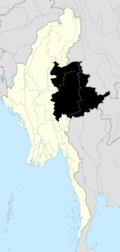Namhsan
Namhsan
နမ့်ဆန်မြို့ | |
|---|---|
Town | |
| Country | Myanmar |
| Division | Shan State |
| District | Tawngpeng |
| Population (2005) | |
| • Ethnicities | Palaung |
| • Religions | Buddhism Hinduism |
| Time zone | UTC+6.30 (MST) |
Namhsan (Template:Lang-my; Palaung: Om-yar; Chinese: 南山), also spelt Namh San, Namsan, or Nam San, is the capital of Tawngpeng District in northern Shan State of Myanmar (Burma). The town is a popular starting point for trekking to Hsipaw.
Besides its Palaung residents, the town is also populated by Karen, Lisu, and Shan ethnic tribal groups, as well as Indian and Chinese residents.
History
During British rule in Burma (Myanmar), Namhsan was the capital of Tawngpeng State, a Palaung substate of the Shan States iBritish Burma; and the only Palaung kingdom in the former Shan States. The people of the town were predominantly of the Ka-tur (Samlong) tribe.[1] The people of the tribe are often referred to as the Golden Palaung (Shwe Palaung) because of their coloured belts.[2] Historically, they wore silver belts for special occasions, but aluminum has since been used instead.
Their language is called Shwe, a language variant that is only partially intelligible by other Palaungic language speakers. [3] In Shwe, Namhsan means trembling waters and the town is thought to be named that way because it is situated on a marsh which gets flooded during heavy rains. During the 1920s and 1930s, the town prospered from the presence of silver mines and the tea grown in the area. The tribe was heavily studied by anthropologist Mrs. Leslie Milne.
References
- ^ Milne, Mrs. Leslie (1924) The Home of an Eastern Clan: A study of the Palaungs of the Shan states Clarendon Press, Oxford, England, OCLC 5226811
- ^ Marshall, Andrew (2002) The Trouser People: a story of Burma-in the shadow of the Empire Counterpoint, Washington, D.C., ISBN 1-58243-120-5
- ^ "Overview of the Shwe De'ang" Asiaharvest.org, last accessed 5 October 2010


